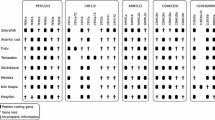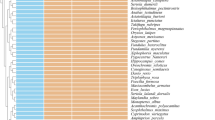Abstract
Circadian rhythms underlie diverse life functions ranging from cellular activities to behavior. Multiple clock genes play a central role in the generation of these rhythms. We partially characterized two copies of the Clock gene from Chinook salmon (Oncorhynchus tshawytscha), OtsClock1a and OtsClock1b. The 6,460 bp OtsClock1a sequence contains 16 exons, 15 introns and encompasses three highly conserved domains indicating it is a novel member of the bHLH-PAS superfamily of transcription factors. The second copy, OtsClock1b, consists of five exons and five introns spanning 1,945 bp. A polyglutamine repeat motif (PolyQ), characteristic of a majority of CLOCK proteins, is present in both OTSCLOCK1a and OTSCLOCK1b. However, the Chinook PolyQ domains are uniquely positioned inside the gene. Interestingly, a 1,200 bp non-coding segment located downstream of the OtsClock1a PolyQ domain is absent from OtsClock1b. This insertion/deletion is 91% similar to the Salmo salar Transferrin gene. A phylogenetic analysis of 11 CLOCK proteins shows that OtsClock1a and OtsClock1b are paralogs which likely arose subsequent to the salmonid genome-wide duplication event. Ultimately, the Chinook salmon Clock genes are key components to our understanding the genetic mechanisms underlying temporally regulated life history traits in Pacific salmonids.




Similar content being viewed by others
References
Allada R, White NE, So WV, Hall JC, Robash M (1998) A mutant Drosophila homolog of mammalian Clock disrupts circadian rhythms and transcription of period and timeless. Cell 93:791–804
Allendorf FW, Thorgaard GH (1984) Tetraploidy and the evolution of salmonid fishes. In: Turner B (ed) Evolutionary genetics of fishes. Plenum Press, New York, pp 1–53
Altschul SF, Gish W, Miller W, Myers EW, Lipman DJ (1990) Basic local alignment search tool. J Mol Biol 215:403–410
Antoch MP, Song EJ, Chang AM, Vitaterna MH, Zhao Y, Wilsbacher LD, Sangoram AM, King DP, Pinto LH, Takanashi JS (1997) Functional identification of the mouse circadian Clock gene by transgenic BAC rescue. Cell 89:655–667
Avivi A, Albrecht U, Oster H, Joel A, Beiles A, Nevo E (2001) Biological clock in total darkness: the Clock/MOP3 circadian system of the blind subterranean mole rat. Proc Natl Acad Sci U S A 98:13751–13756
Bacolla A, Wells RD (2004) Non-B DNA conformations, genomic rearrangements, and human diseases. J Biol Chem 279:47411–47414
Bailey GS, Poulter RT, Stockwell PA (1978) Gene duplication in tetraploid fish: model for gene silencing at unlinked duplicated loci. Proc Natl Acad Sci U S A 78:5575–5579
Chang DC, McWatters HG, Williams JA, Gotter AL, Levine JD, Reppert SM (2003) Constructing a feedback loop with circadian clock molecules from the silkmoth, Antheraea pernyi. J Biol Chem 278:38149–38158
Chappell PE, White RS, Mellon PL (2003) Circadian gene expression regulates pulsatile gonadotropin-releasing hormone (GnRH) secretory patterns in the hypothalamic GnRH-secreting GT1–7 cell line. J Neuro 23:112022–11213
Children’s Hospital Oakland Research Institute [http://bacpac.chori.org/highdensity.htm]
Cronn R, Cedroni M, Haselkorn T, Grover C, Wendel JF (2002) PCR-mediated recombination in amplification products derived from polyploidy cotton. Theor Appl Genet 104:482–489
Darlington TK, Wager-Smith K, Ceriani MF, Staknis D, Gekakis N, Steeves TDL, Weitz CJ, Takahashi JS, Kay SA (1998) Closing the circadian loop: Clock-induced transcription of its own inhibitors per and tim. Science 280:1599–1603
Felsenstein J (1991) PHYLIP: phylogeny inference package, version 3.4. Department of Genetics, SK-50, University of Washington, Seattle
Force A, Lynch M, Pickett FB, Amores A, Yan YL, Postlethwait J (1999) Preservation of duplicate genes by complementary, degenerative mutations. Genetics 151:1531–1545
Gately KA (2000) Regulation of the Atlantic salmon (Salmo salar) transferrin gene and liver gene expression. Thesis (Ph.D.): National University of Ireland, Galway pp 197–224
Gekakis N, Staknis D, Nguyen HB, Davis FC, Wilsbacher LD, King DP, Takahashi JS, Weitz CJ (1998) Role of the CLOCK protein in the mammalian circadian mechanism. Science 280:1564–1569
Hall T (1997) BioEdit Sequence Alignment Editor. Ibis Therapeutics, Carlsbad, Ca
He X, Zhang J (2006) Rapid subfunctionalization accompanied by prolonged and substantial neofunctionalization in duplicate gene evolution. Genetics 169:1157–1164
Hirayama J, Kaneko M, Cardone L, Cahill G, Sassone-Corsi P (2005) Analysis of circadian rhythms in zebrafish. Methods Enzymol 393:186–204
Hughes A (1994) The evolution of functionally novel proteins after gene duplication. Proc R Soc Lon B 256:119–124
Jeffreys AJ, Neil DL, Neumann R (1998) Repeat instability at human minisatellites arising from meiotic recombination. EMBO J 17:4147–4157
Kimura A, Ohta T (1974) On some principles governing molecular evolution. Proc Nat Acad Sci U S A 71:2848–2852
King DP, Zhao YL, Sangoram AM, Wilsbacher LD, Tanaka M, Antoch MP, Steeves TDL, Vitaterna MH, Kornhauser JM, Lowrey PL, Turek FW, Takahashi JS (1997) Positional cloning of the mouse circadian CLOCK gene. Cell 89:641–653
Looby P, Loudon ASI (2005) Gene duplication and complex circadian clocks in mammals. Trends Genet 21:46–53
Matsuo T, Yamaguchi S, Mitsui S, Emi A, Shimoda F, Okamura H (2003) Control mechanism for the circadian clock for timing of cell division in vivo. Science 202:255–259
Mazurais D, Le Drean G, Brierley I, Anglade I, Bromage N, Williams LM, Kah O (2000) Expression of clock gene in the brain of rainbow trout: comparison with the distribution of melatonin receptors. J Comp Neurol 422:612–620
McNamara P et al (2001) Regulation of CLOCK and MOP4 by nuclear hormone receptors in the vasculature: a humoral mechanism to reset a peripheral clock. Cell 105:877–889
Mitchell PJ, Tijian R (1989) Transcriptional regulation in mammalian cells by sequence-specific DNA binding proteins. Science 245:371–378
Near TJ, Parker SK, Detrich HW (2006) A genomic fossil reveals the key steps in hemoglobin loss by the Antarctic icefishes. Mol Biol Evol 23:2008–2016
Ohno S, Wolf U, Atkin NB (1968) Evolution from fish to mammals by gene duplication. Hereditas 59:169–187
Reppert SM, Weaver DJ (2002) Coordination of circadian timing in mammals. Nature 418:935–941
Richard G-F, Paques E (2000) Myotonic dystrophy: RNA pathogenesis comes into focus. Am J Hum Genet 74:793–804
Saleem Q, Anand A, Jain S, Brahmachari SK (2001) The polyglutamine motif is highly conserved at the Clock locus in various organisms and is not polymorphic in humans. Hum Genet 109:136–142
Schultz J, Milpetz F, Bork P, Ponting CP (1998) SMART, a simple modular architecture research tool: identification of signaling domains. Proc Natl Acad Sci U S A 95:5857–5864
Schwassmann HO (1988) Biological rhythms. In: Hoar WS, Randall DJ (eds) Fish Physiology. Academic Press, New York, pp 371–416
Steeves TDL, King DP, Zhao Y, Sangoram AM, Du F, Bowcock AM, Moore RY, Takahashi JS (1999) Molecular cloning and characterization of the human CLOCK gene: expression in the superchiasmatic nuclei. Genomics 57:189–200
Thompson JD, Higgins DG, Gibson TJ (1994) CLUSTAL W: improving the sensitivity of progressive multiple sequence alignment through sequence weighting, position specific gap penalties and weight matrix choice. Nucleic Acids Res 22:4673–4680
Verstrepen K, Jansen A, Lewitter F, Fink G (2005) Intragenic tandem repeats generate functional variability. Nat Genet 37:986–990
Vitaterna MH, King DP, Chang AM, Kornhauser JM, Lowery PL, McDonald JD, Dove WF, Pinto LH, Turek FW, Takahashi JS (1994) Mutagenesis and mapping of a mouse gene, Clock, essential for circadian behavior. Science 264:719–725
Whitmore D, Foulkes NS, Strahle U, Sassone-Corsi P (1998) Zebrafish Clock rhythmic expression reveals independent peripheral circadian oscillators. Nature Neurosci 1:701–707
Yoshimura T, Suzuki Y, Makino E, Suzuki T, Kuroiwa A, Matsuda Y, Namikawa T, Ebihara S (2000) Molecular analysis of avian clock genes. Mol Brain Res 78:207–215
Acknowledgements
This research was supported by the California Department of Water Resources and the Mamie M. Markham Research Grant. We are grateful to M. Camara and G. Moyer for comments that considerably improved the manuscript and I. Meusnier for help with mRNA sampling and screening the BAC library. We thank B. Devlin of the Department of Fisheries and Oceans, British Columbia, Canada for providing reagents, laboratory equipment, and technical support to probe the Chinook salmon BAC library.
Author information
Authors and Affiliations
Corresponding author
Rights and permissions
About this article
Cite this article
O’Malley, K.G., Banks, M.A. Duplicated Clock genes with unique polyglutamine domains provide evidence for nonhomologous recombination in Chinook salmon (Oncorhynchus tshawytscha). Genetica 132, 87–94 (2008). https://doi.org/10.1007/s10709-007-9151-8
Received:
Accepted:
Published:
Issue Date:
DOI: https://doi.org/10.1007/s10709-007-9151-8




